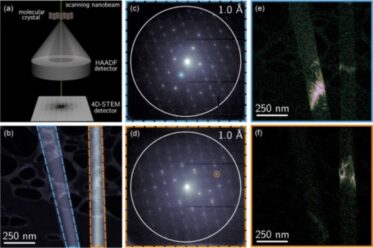Scientific Achievement

Discovery of two consequences of radiation damage. Internal structure is constantly rearranged en route to destruction and radical propagation is delocalized from initial scattering event.
Significance and Impact
Radiolytic damage is the fundamental limit constraining all EM observations, yet very little is known about it. Our dual space technique analyzes its progression in beam sensitive crystals.
Research Details
- Uniquely enabled by the 4D Camera and NERSC to record 200 consecutive scans to track radiation induced changes over time.
- The team discovered that electron beams create expanding zones of damage that spread far beyond the direct beam footprint, termed “impact craters”.
- The extent of damage depends on the resolution being observed—high-resolution features are destroyed over larger areas than low-resolution ones.
Saha, A., Mechlenberg, M., Pattison, AJ., Brewster, AS., Rodriguez, J.A., Ercius, PE. Phys Rev Lett. 134, 146101. (2025) DOI:10.1103/PhysRevLett.134.146101
Research Summary
A team of Foundry staff and users have developed a groundbreaking technique to simultaneously watch how electron beams damage molecular crystals in both real space (what we can see) and reciprocal space (diffraction patterns). Using 4D scanning transmission electron microscopy (4D-STEM) and the 4D Camera, they captured “dual-space movies” showing exactly how crystalline structures break down under electron bombardment—something that has been a major limitation in electron microscopy for decades. This work addresses one of the most fundamental problems in electron microscopy: radiation damage. Every time scientists use electron beams to study materials, they inevitably damage what they’re trying to observe. Until now, researchers could only see the end result—disappearing diffraction spots—without understanding the underlying physical processes.
The team discovered that focused electron beams create expanding zones of damage that spread far beyond the direct beam footprint, like ripples in a pond. These “impact craters” grow as reactive molecules (free radicals) diffuse outward from the initial damage site, destroying crystal structure in their path. Contrary to expectations, some crystal regions don’t just fade away uniformly. Instead, they can temporarily become more visible in diffraction patterns before ultimately disappearing, as damaged areas rearrange themselves into new orientations that briefly diffract more strongly. The extent of damage depends on the resolution being observed—high-resolution features are destroyed over larger areas than low-resolution ones, revealing that different levels of crystal organization have different vulnerabilities to radiation damage.

